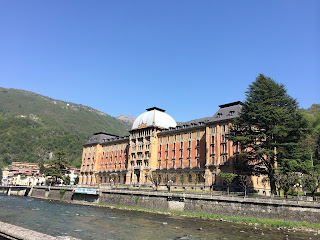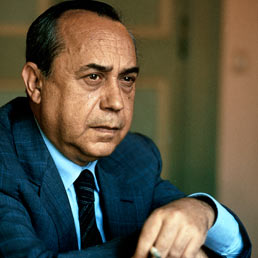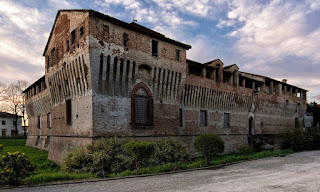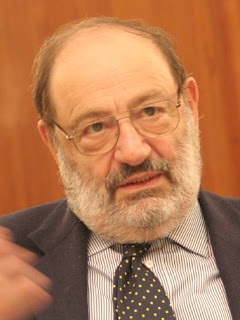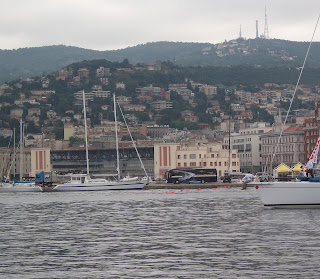Novelist likened to Camus whose short stories remain popular
 |
| Dino Buzzati was a journalist, author and painter in an extraordinary career |
Buzzati’s most famous novel, Il deserto dei Tartari (1940), titled The Tartar Steppe in the English translation, saw Buzzati compared to Albert Camus and Franz Kafka as a work of existentialist style, but it is for his short stories that he still wins acclaim.
A new collection entitled Catastrophe and Other Stories, which showcases Buzzati’s talent for weaving nightmarish fantasy into ordinary situations, was published earlier this year.
Buzzati, who worked as journalist for the whole of his adult life and also painted prolifically, was the second of four children born to Giulio Cesare Buzzati, a distinguished professor of international law, and Alba Mantovani, a veterinarian born in Venice.
The family’s main home was in Milan but they had a summer villa in San Pellegrino, a village just outside Belluno in the foothills of the Dolomites, which was where Dino was born.
 |
| Dino Buzzati, pictured in his studio, was almost as prolific as a painter as he was a writer |
At different times he was a war correspondent, embedded with the Italian navy, editor, essayist, foreign correspondent, crime reporter and art critic.
He began to write fiction in the early 1930s with two novels set in the mountains, inspired by the landscapes around Belluno. Barnabò delle montagne (Barnabus of the Mountains, 1933) and Il segreto del bosco vecchio (The Secret of the Ancient Wood, 1935), both of which were made into films in the 1990s, introduced the Kafkaesque surrealism, symbolism, and absurdity that was a characteristic of all his writing.
 |
| Buzzati pictured near the offices of Corriere della Sera on Via Solferino in Milan |
The novel was turned into a movie in 1976 under the direction of Valerio Zurlini and starring Vittorio Gassman and Giuliano Gemma, with a soundtrack by Ennio Morricone.
Buzzati’s collections of short stories include Sessanta racconti (Sixty Tales, 1958), while other novels include Il grande ritratto (Larger Than Life, 1960), a science fiction novel, and Un amore (A Love Affair, 1963).
Of his plays, which were hugely popular, the most important is Un caso clinico (A Clinical Case, 1953), a Kafkaesque horror story in which medical specialists and machinery freakishly kill a perfectly healthy man. His children’s novel, La famosa invasione degli orsi in Sicilia (The Bears' Famous Invasion of Sicily, 1945) is still a favourite today.
Buzzati’s paintings ranged from his early landscapes, depicting his beloved mountains, to the Italian black comic art and the pop art that dominated his work in the 1960s. His most famous painting is probably his Piazza del Duomo (1952), in which Milan cathedral’s distinctive grid of pinnacles and spires becomes a jagged Dolomite mountain, surrounded by green pastures.
He was also a devotee of the opera, writing the libretto for four operas for which the music was composed by his friend, Luciano Chailly. Away from his extraordinary productivity in words and pictures, he would spend every September in the mountains around Belluno, climbing difficult routes in the company of mountain guides.
Buzzati, who did not marry until he was almost 60 years old, died in 1972 after developing pancreatic cancer. His ashes were scattered on Croda di Lago, a mountain in the Dolomites near Cortina d’Ampezzo.
 |
| Piazza dei Martiri is one of the central squares in the beautiful town of Belluno in northern Veneto |
Belluno, in the Veneto region, is a beautiful town in the Dolomites, situated just over 100km (62 miles) north of Venice, more than 325km (200 miles) from Milan. It occupies an elevated position above the Piave river surrounded by rocky slopes and dense woods that make for an outstanding scenic background. The architecture of the historic centre has echoes of the town's Roman and medieval past. Around the picturesque Piazza Duomo can be found several fine buildings, such as the Palazzo dei Rettori, the Cathedral of Belluno and Palazzo dei Giuristi, which contains the Civic Museum.
 |
| The Villa Buzzati is now available for guests to stay in bed and breakfast accommodation |
Visitors to Belluno can stay at Buzzati’s family villa in Via Visome, about 4km (2.5 miles) from the centre of the town. It is managed by Valentina Morassutti, whose grandmother was Dino Buzzati’s sister. The Villa Buzzati has two rooms that are available all year round for guests wishing to stay on a bed and breakfast basis. On the first Sunday of each month from April to October, Morassutti can arrange small-group visits to the Villa and the places that were dear to Buzzati.
More reading:
Why Alberto Moravia is remembered as a major literary figure
The brilliance of Strega Prize winning novelist Corrado Alvaro
What made Vittorio Gassman one of Italy's finest actors
Also on this day:
1885: The birth of athlete Dorando Pietri, famous for being disqualified
1978: The election of Pope John Paul II
Home



